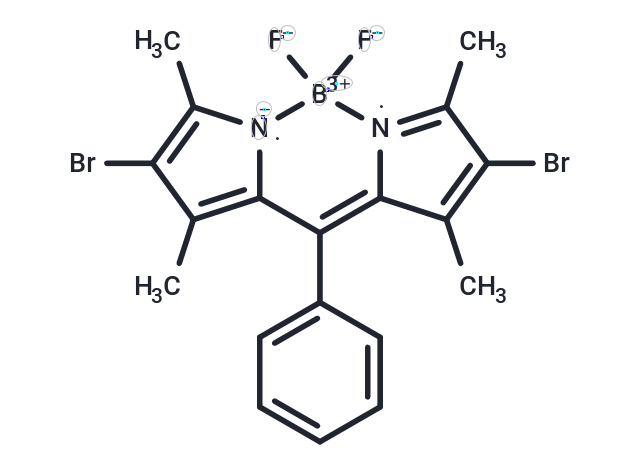Shopping Cart
Remove All Your shopping cart is currently empty
Your shopping cart is currently empty
8-Phenyl-2,6-dibromo-1,3,5,7-tetramethyl BODIPY can be used in photodynamic therapy.

| Pack Size | Price | USA Warehouse | Global Warehouse | Quantity |
|---|---|---|---|---|
| 25 mg | $30 | - | In Stock | |
| 50 mg | $38 | - | In Stock | |
| 100 mg | $52 | - | In Stock |
| Description | 8-Phenyl-2,6-dibromo-1,3,5,7-tetramethyl BODIPY can be used in photodynamic therapy. |
| Targets&IC50 | HeLa cells:5.2 μM |
| Animal Research | I. Application of photodynamic therapy 1. Material preparation (1) 8-Phenyl-2,6-dibromo-1,3,5,7-tetramethyl BODIPY: usually dissolved in an appropriate organic solvent (such as dichloromethane, ethanol or DMSO). Cell or animal model: use cultured cancer cells (such as HeLa, MCF-7, etc.) or animal models. (2) Light source: a light source with a specific wavelength (such as a fiber laser, the excitation wavelength is usually in the range of 480-500 nm) can be used for irradiation. (3) Culture medium or injection solution: for cell experiments, use conventional cell culture medium; for animal experiments, use physiological saline or appropriate buffer. 2. Experimental steps (1) Cell experiment: dissolve 8-Phenyl-2,6-dibromo-1,3,5,7-tetramethyl BODIPY and add it to the cancer cell culture medium and incubate for a period of time (usually 2-4 hours). Then, the cells are illuminated with light of a specific wavelength to observe changes in cell activity (such as detecting cell survival rate through the MTT method, cell viability kit, etc.). (2) Animal experiments: The photosensitizer is injected into the animal body by intravenous injection or local application, and the appropriate time is selected for light irradiation. After illumination, indicators such as tumor size and tissue pathological changes are observed. (3) ROS detection: Fluorescent probes (such as DCFH-DA, DHE, etc.) are used to detect ROS generated under illumination. II. Fluorescence imaging 1. Working solution concentration: The concentration range used in general fluorescent labeling experiments is 1 μM to 10 μM, but the concentration may be adjusted depending on the target molecule, the required fluorescence intensity, and the specific experimental conditions. For more sensitive experiments, the concentration can be as low as 0.1 μM. 2. Fluorescence imaging steps (1) Inject 8-Phenyl-2,6-dibromo-1,3,5,7-tetramethyl BODIPY into the animal body or add it to the cell culture medium. (2) Use appropriate fluorescence microscope or fluorescence imaging equipment to observe its distribution in vivo or in cells. |
| Molecular Weight | 481.97 |
| Formula | C19H17BBr2F2N2 |
| Cas No. | 910823-84-6 |
| Smiles | [F-][B+3]1([F-])[N]=2C(=C(C=3C=CC=CC3)C4=C(C(Br)=C([N-]41)C)C)C(=C(Br)C2C)C |
| Relative Density. | no data available |
| Storage | Powder: -20°C for 3 years | In solvent: -80°C for 1 year | Shipping with blue ice/Shipping at ambient temperature. |
| Size | Quantity | Unit Price | Amount | Operation |
|---|

Copyright © 2015-2025 TargetMol Chemicals Inc. All Rights Reserved.